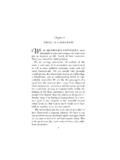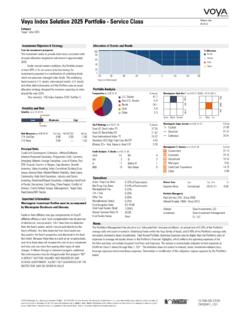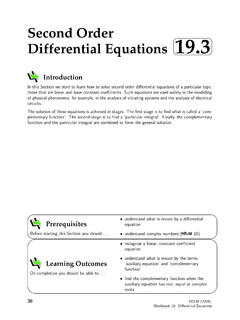Transcription of Chapter 19 Electric Charges, Forces, and Fields
1 Chapter 19 Electric charges , Forces, and FieldsOutline19-1 Electric Charge19-2 Insulators and Conductors19-3 Coulomb s Law (and net vector force )19-4 The Electric Field19-5 Electric field Lines19-6 Shield and Charging by Induction19-7 Electric Flux and Gauss s Law19-1 Electric ChargeThe effect of Electric charge have been known for a long time. Objectives: What is Electric charge How it is created Electric charge propertiesFigure 19-1 Charging an Amber Rod(a). Uncharged amber exert no force on papers.(b). Rod amber is rubbed against a piece of fur.(c). Amber become charged and then attracts the papers. Figure 19-2 Likes Repel, Opposites AttractAmber (-) + Amber (-): RepelAmber (-1) + glass (+): AttractConclusions:There are two type of charges (in amber and glass), which is illustrated in Fig.
2 19-2 Properties The like or same charges repel. The opposite or different charges attract. Positive charge (+) Negative charge (-) Object with zero net charge are said to be electrically good example of neutral object is the atom,as shown in Fig. 19-3. Figure 19-3 The Structure of an Atom:proton and electrons have the same Electric charge. Electron is negative, and is defined with a magnitude e, giving by:Magnitude of an Electron s Charge, eSI unit: coulomb, 10(19 1)eC = The electron has a 10(19 2)eMkg = In contrast, the charge on proton(one constituent of the nucleus) is positive (+e). The mass of proton 10(19 3)pmkg = The other constituent of the nucleus is the neutron, which has zero charge. Its mass 10(19 4)nmkg = Figure 19-4 Charge Transfer(a) Initially, an amber rod and a piece of fur is electrically neutral: no more negative/positive charge!
3 (b) charges is transferred from one to the other. (c) At the end, the fur and the amber have charges of equal magnitude, but opposite Separation /TransferConservation of Electric ChargeThe total Electric charge of the universe is constant:No physical process can increase or decrease the total amount of Electric conceptsDue to the movement of electrons, charge is transferred from one object to Ion:The atom that loses an electron is said to be a positive ion;Negative Ion:The atom that receives an extra electron is said to be a negative ion;19-2 Insulators and Conductors Insulator: charges cannot move about freely on : amber, glass, wood, rubber. Conductor: charges can move freely on : different metals and metal wires. Semiconductor:Materials have properties of Electric conduction between insulator and semiconductors have wide application in electronics!
4 Figure 19-6 Charging a Conductor(a). An uncharged metal sphere is touchedby a charged rod, and some charge is transferred to it.(b). charges move freely on a conductor, and spread out uniformlybecause of the same charge Coulomb s Law122922,(195) kN m C= = Coulomb s law for the magnitudeof the electrostatic force between two point chargesSI unit: newton, NFigure 19-7 Forces Between Point ChargesNote: the mass of proton is ~ 2000 times that of the electron ! Note: the mass of proton is ~ 2000 times of the electron ! An Example: Calculate the magnitude of Electric force between a electron and a proton at a distance of r= x 10 10( )( 10) 10qqFkrCCNm CmN = = = According to Coulomb s lawAn Example 19-9: The attraction electrostatic force between the point charges + and Q has a magnitude of N when the separation between the charges is m.
5 Find the sign and magnitude of the charge Q. ()( )()() 10 10 N m / 10 CrFQkq === Negative charge andThe magnitude of the charge Q isExample 19-1:The Bohr OrbitIn the Borh s Hydrogen model, the electron is imagined to move in a circular orbit about a stationary proton. The force responsible for the electron circular motion is the Electric force between the electron and the proton. Given that the radius of the electron s orbit is , and its mass is me= Find the electron s Set the coulomb force between the electron and proton equal to the centripetal forcerequired for the electro s circular orbit:122222ecpeqqkmarevkmrr==2. Solve for the speed of the electron, v:ekvemr=3. Substitute numerical (1 . 6 01 0)(9 .1 1 1 0)(5 .2 91 0) 10/Nm CvCkgmms = = The Electric force , like all forces, is a vector.
6 Hence, a charge experiences forces due to two or more charges is the vector sumof all the examples, in Fig. 19-8, the total forceon charge 1 is the vector sum of the forces due to charges 2, 3 ,4 SuperpositionFigure 19-8 Superposition of Forces1121314FF F F=++JG JG JG JGVector sum/ Net force :Example 19-15:Net ForceFor three charges , given q= +12 uC and d= 16 cm. (a) Find the direction and magnitude of the net electrostatic force exerted on the point charge q2in the following figure. (b) How will your answer change if the distance d were tripled?Note: 1 uC=10-6 CSolution(a)Write Coulomb s law using vector notation:13122212322 qqqqkkdd=+= +FF FxxGGG[]()()()[] []()()()()212132229226222 10 N m / C12 10 C mkkqq qqqqqqddkqd = + = + ===FxxxxxGSubstitute the charge magnitudes given in the figureThe net electrostatic force on q2is3200 kN toward q=(b) If the distance dwere tripled, the magnitude would be cut to a ninth and the direction would be unchanged.
7 Example 19-21:Superposition(a) Find the direction and magnitude of the net force exerted onthe point charge q3in the figure. Let q= + uC and d= 33cm. (b) How would your answer change if the distance d were double?Picture the problemSolution1. (a)Find4FG()() kq qkq qkqddd===FxxxG2. Find 1FG()() kq qkq qkqddd===FyyyG3. Find ()()()()()() cos 45sin 2 4kq qkqqddkqd = = = xyFxyxyG()()()()()()()()()22 2 442 Nm/C C 442 m Nkqkqkqkqdd ddkqd = + = + = + =+ the direction ofnetFGfrom the +xaxis:net, 11net, NyxFF == = 6. Find the magnitude ofnetFG()()2222net,, Nnet xnet yFFF=+= + =4. Find the vector sum of the three forces:7. (b) If the distance dwere doubled, the magnitude of the force would be cut to one-fourth and the direction would be unchanged.
8 SuperpositionFor case of more than two forces, the net force vector +++JG JG JG JGThe X and Y components of the net force are,1,2,3,..netxxxxFFFF=+++,1,2,3,..net yyyyFFFF=+++The magnitude and direction of the net force are22,,netnet xnet yFFF=+1,,tan (/)net ynet xFF =Summary1) There are two kinds of charge: positive (+) and negative (-) ) Like charges repel; different charges attract. 3) Electric charge conservation: the total charges are constant in the ) Insulator, semiconductor, and ) Coulomb s law6) Superposition (based on Coulomb s law): net vector ,(195)qqFkr= Picture the problemExample 19-3:SuperpositionThree charges , each equal to + uC, are placed at three corners of a square m on a side, as shown in the diagram. Find the magnitude and direction of the net force on charge number 3 Solution1.
9 Find the magnitude of 31 FJG13312629222(2)( 10)(8 .9 91 )2( ) CmN = = =2. Find the magnitude of32 FJG23322629222()( 10)(8 .9 91 )( ) CmN = = =3. Calculate the two orthogonal components of and31 FJG32 FJG31,31cos ( )( ) ==31,31sin ( )( ) ==32,32cos 0( )(1) ==32,32sin 0( )(0)0yFFNN= ==4. Calculate the net force3 FJG3,31,32, += + =3,31,32, += +=222233,3,( )( ) +=+=5. Find the direction of3 FJG3,1133, ()tan() ===















